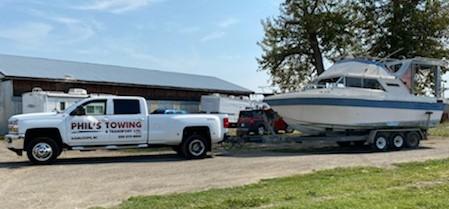Step-by-Step Guide to Preparing Your C-Can for Transportation on a Flatbed Truck
August 22nd 2024

At Phil’s Towing, as part of our trailer hauling services, we provide safe and efficient transportation of c-cans, also known as sea cans. Both terms—c-can and sea can—refer to the same type of shipping container used for transporting goods. We’re based in Kamloops but offer c-can transportation services to and from anywhere within BC. With enough notice, we can help you across Canada too!
Whether you're new to shipping containers or a seasoned pro, we've put together this step-by-step guide to help you prepare your c-can for transport on our flatbed truck.
1. Inspect the C-Can
Before we arrive to pick up your c-can, we recommend a thorough inspection for any structural damage, leaks, or weaknesses. Check the following:
- Exterior Walls: Look for dents, rust, or holes.
- Roof: Ensure it is free from leaks or significant wear.
- Doors and Seals: Make sure the doors open and close properly and the seals are intact to prevent water ingress.
2. Secure the Contents
Properly securing the contents inside your sea can is crucial to prevent shifting during transport. Here’s how you can do it:
- Heavy Items First: Place heavier items on the bottom and lighter items on top.
- Even Weight Distribution: Ensure the weight is evenly distributed to maintain balance.
- Straps and Ties: Use strong straps, ropes, or nets to tie down items securely.
- Padding and Bracing: Use padding to fill gaps and prevent movement. Brace items against the walls if necessary.
3. Label the C-Can
Labeling your sea can helps us handle it properly during transport. Make sure to include:
- Contents Description: Briefly describe the contents on the label.
- Fragile Items: Mark any sides that need special handling or contain fragile items.
- Contact Information: Include your contact details for any inquiries during transport.
4. Ensure Proper Documentation
Having the correct paperwork is essential for a hassle-free transport process. Here’s what you’ll need:
- Bill of Lading: This document serves as a receipt and contract for the shipment.
- Insurance Papers: Ensure your cargo is insured against potential damages.
- Permits and Licenses: Obtain any necessary permits for transporting oversized or hazardous materials.
5. Prepare the Loading Site
To make the loading process smooth, ensure the loading area is ready for our flatbed truck’s arrival:
- Clear Access: Ensure there is enough space for the truck to maneuver and park.
- Ground Conditions: Check that the ground is stable and can support the weight of the truck and c-can.
- Loading Equipment: Have forklifts, cranes, or other necessary equipment ready to assist in loading.
6. Coordinate with Phil’s Towing
Clear communication is key. Here’s what we’ll need from you:
- Schedule and Timing: Confirm the pickup time and expected delivery date.
- Special Requirements: Inform us of any special handling instructions or requirements.
- Contact Person: Provide the name and contact details of the person overseeing the loading and unloading.
7. Load the C-Can Safely
During the loading process, our team will ensure that your sea can is properly positioned on the flatbed truck:
- Centering: We’ll place the c-can in the center of the flatbed to distribute weight evenly.
- Securing: We use chains, straps, and tensioners to secure the c-can to the truck bed firmly.
- Double-Check: Before we depart, we’ll double-check all securing points to ensure they are tight and secure.
8. Final Inspection
Before the truck hits the road, we conduct a final inspection:
- Check Securing Points: Ensure all straps and chains are still secure.
- Inspect the Sea Can: Do a quick walk-around to check for any visible issues.
- Verify Documentation: Make sure all paperwork is complete and accompanies the shipment.
9. Monitor the Transport
We stay in contact with you throughout the transport process:
- Regular Updates: We’ll provide updates on the progress and any potential delays.
- Arrival Coordination: Be prepared at the destination to receive your c-can promptly.
By following these steps, you can ensure that your c-can (or sea can) is well-prepared for transportation on our flatbed truck. At Phil’s Towing, we’re dedicated to making your transport experience smooth, safe, and efficient. If you have any questions or need further assistance, don't hesitate to reach out to us.
Ask About C-Can Transportation











